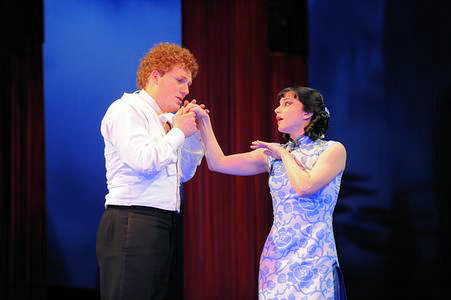Other Links
Editorial Board
- Editor - Bill Kenny
- London Editor-Melanie Eskenazi
- Founder - Len Mullenger
Google Site Search
SEEN
AND HEARD INTERNATIONAL OPERA REVIEW
Franz Lehár, Das Land des Lächelns
(The Land of Smiles):
at Volksoper, Vienna, 10.4.2008 (GF)
Production:
Directed by Beverly Blankenship
Sets by Heinz Hauser
Costumes by Elisabeth Binder-Neururer, assisted by Susanne
Bisovsky (Wiener Chic)
Choreography by Allen Yu
Cast:
Count Ferdinand Lichtenfels / Tschang, Sou-Chong’s uncle –
Heinrich Schweiger
Lisa,
Count Lichtenfels’s daughter – Marion Costa
Count Gustav von Pottenstein, a.k.a. Gustl – Daniel Schmutzhard
A
General / Eunuch – Gerhard Ernst
Prince Sou-Chong – Ki-Chun Park
Mi, Sou-Chong’s sister – Katja Reichert
and
others
Chorus and Orchestra of the Volksoper, Vienna, The Ballet of the
Vienna State Opera and Volksoper, Conducted by Michael Tomaschek
Franz Lehár worked on this score
from 1918 to 1923 when it was premiered on 9 February 1923 at
Theater an der Wien (the same house where his breakthrough
operetta Die lustige Witwe was premiered almost twenty
years earlier) under the title Die gelbe Jacke (The Yellow
Jacket). It wasn’t a success but Lehár didn’t want to scrap it
altogether and revised it, partly in collaboration with Richard
Tauber, who came up with the theme that later turned out to be the
hit song of hit songs: Dein ist mein ganzes Herz. In this
new guise, conducted by the composer and with Tauber in the role
as Prince Sou-Chong, it was a resounding success at the
Metropoltheater in Berlin on 10 October 1929 and it soon spread
around the world. In Vienna it was first played in 1930 at the
Theater an der Wien and in 1938 it arrived at the State Opera,
where four years earlier the opera Giuditta had been
triumphantly premiered. Again the composer was in the pit and
Tauber sang Sou-Chong against Maria Reining. At Volksoper, Das
Land des Lächelns has been a mainstay since May 1956 in a
number of stagings. The first production had the Swedish tenor Per
Grundén as Sou-Chong. Rudolf Christ, Rudolf Schock, Nicolai Gedda,
Helge Rosvaenge and Adolf Dallapozza were other famous tenors who
created the Chinese prince during 294 performances until December
1976. In February 1986 it was time for a new production, this time
with the noted Wagner tenor Siegfried Jerusalem as the prince and
in 1996 Klaus Maria Brandauer directed a third production with
Johan Botha as Sou-Chong. The present production was premiered on
23 February this year and the performance I saw was the eighth.
Daniel Schmutzhard (Gustl) and Katja Reichert (Mi)
The first act, playing in Vienna, is also very beautiful with a
backdrop of flowers and movable glass walls to separate indoor
activities from outdoor. For my taste the act becomes too
longwinded with all the social business, including the five girls
who interfere time after time. They appear also in the third act
and I don’t know if this is in accordance with the original
libretto. The main conflict in Das Land des Lächelns is of
course the opposition between West and East, between the European
conventions and the Chinese – at least from the point of view of
the original setting, roughly just before WW1. Here the costumes
and the manners are period, Gustl even arrives in China by air
balloon. Today we know, through media, much more about these
differences and can better understand why the marriage between
Lisa and Sou-Chong failed. But when two young people, who
obviously are truly in love, have to give up
their relationship for social reasons, we are still emotionally affected and there were
sobs and tears in the audience by the end of the operetta.
The director has managed to balance the serious and comic elements
well – there is always a risk that the tragedy becomes too
sentimental and the comedy too farcical. I regretted though that
Lisa was portrayed as rather silly in the first act – whether by
design or by over-acting from Marion Costa – who was new in the
role – I don’t know. In the following acts she seemed more at ease, was far more convincing and her singing was
first class: a bright, well equalized soprano, not unlike Anneliese Rothenberger’s in her heyday, which is praise indeed.
Korean tenor Ki-Chun Park had the right looks for Prince Sou-Chong
and acted with restraint, which could be seen as part of the
Eastern tradition but – in the case of Das Land des Lächelns
– also a tradition emanating from Richard Tauber. He had collapsed
after a performance of Friederike in early 1929 and could
hardly move, was diagnosed rheumatic and was forced to be very
sparse with movements. Ki-Chun Park sported a spinto tenor with
luminous high notes, not wholly free from strain but in the main
it was a finely sung performance where all the well-known numbers
were well executed and he also scaled down to some beautiful soft
singing. The secondary couple were also splendid and especially
Katja Reichert’s Mi was a pleasure to listen to – and watch – and
it was a pity the lovely duet Zig, zig, zig in the last act
was cut. The conductor Michael Tomaschek paced the performance
well, avoiding sentimentalizing the music and overall this is an
excellent rendering of this indestructible operetta, celebrating
its 80th birthday next year.
The programme book should also be mentioned: 72 pages packed with
information about the work and with cultural and historical
references – plus synopses in English, French, Italian and
Japanese. None in Chinese, though!
Göran
Forsling
Picture © Dimo Dimov /
Volksoper Wien
Back
to Top
Cumulative Index Page
